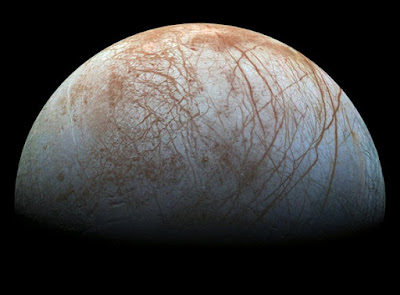 |
| Salt-laden water welling up from below gives Europa’s fissures and cracks their distinctive color. Credit: NASA, JPL-Caltech and SETI Institute |
Topics: Astrobiology, Exoplanets, Planetary Exploration, SETI
The sea sloshing beneath the icy surface of Jupiter’s moon Europa just might be the best incubator for extraterrestrial life in our solar system. And yet it is concealed by the moon’s frozen outer shell—presenting a challenge for astrobiologists who would love nothing more than to peer inside. Luckily they can catch a partial glimpse by analyzing the flavor of the surface. And the results are salty.
A new study published this week in Science Advances suggests that sodium chloride—the stuff of table salt—exists on Europa’s surface. Because the exterior is essentially formed from frozen seawater, the finding suggests that Europa’s hidden sea is drenched in table salt—a crucial fact for constraining the possibilities for life on the alien world.
Not that scientists have tasted a slice of the distant moon. To analyze Europa’s composition, astronomers study the light emanating from its surface, splitting it into a rainbow-like spectrum to search for any telltale absorption or emission lines that reveal the world’s chemistry. There is just one problem: Ordinary table salt is white and thus gives off a featureless spectrum. But harsh radiation—which exists at Europa’s surface in abundance—just might add a dash of color. That much was realized in 2015 when two NASA planetary scientists Kevin Hand and Robert Carlson published a study suggesting the yellowish-brown gunk on Europa might be table salt baked by radiation. To reach that conclusion, Hand and Carlson re-created the conditions on Europa within vacuum chambers—or as Hand calls them, “stainless steel shiny objects that are humming and whizzing.” Next, they placed table salt into those chambers, lowered the pressures and temperatures to simulate Europa’s surface, and blasted the samples with an electron gun to simulate the intense radiation.
Water on Europa—with a Pinch of Salt, Shannon Hall, Scientific American
Comments